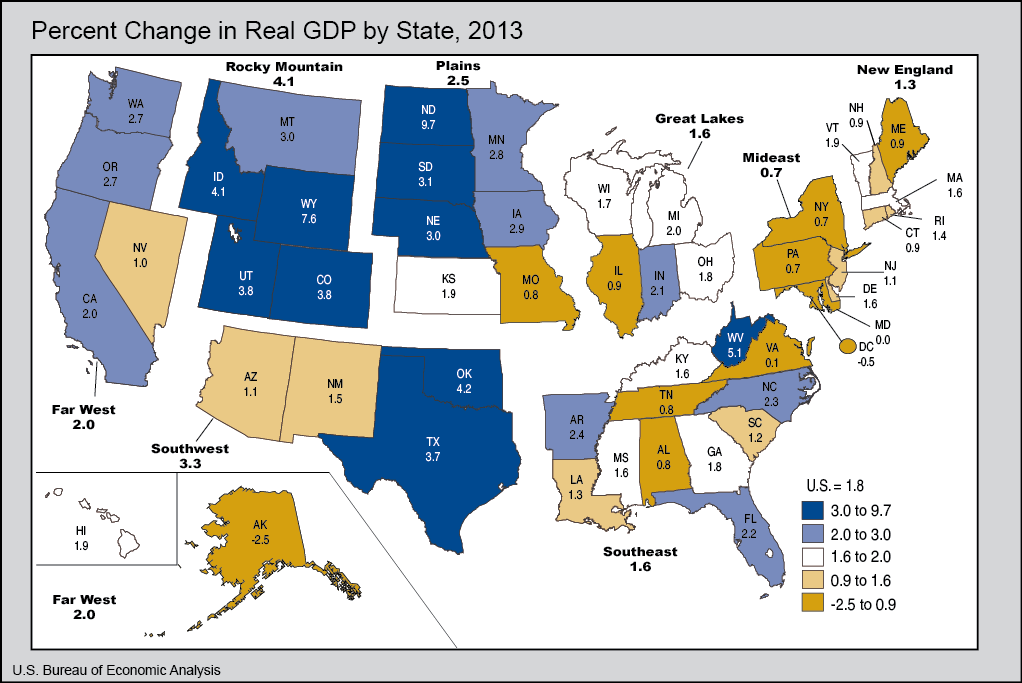The U.S. Bureau of Economic Analysis just recognized California for being in the top half for GDP growth by state in 2013. Governor Jerry Brown likes to crow about California being a leader in nation economic recovery and job growth. But Brown avoids the fact that most of the recovery is along a narrow 48 mile strip of the 101 Freeway betwee Santa Clara and San Francisco counties, known as the “Bay Area.”
With the rest of the state still suffering substantially worse economic conditions, resentment has spawned a secession movement called the “Six Californias” initiative that will likely be on the ballot in November to break-up California into six smaller states.
California was the epicenter of the mortgage crisis that caused the U.S. “Great Recession.” The state lost 1.17 million new jobs between 2007 to 2009, the worst of any state in the nation. Over half of those losses came from construction, real estate and mortgage finance-related firms. Unemployment peaked at 12.4% in December 2009–the 4th worst rate of any state. Adding part-time and discouraged workers (who stopped looking for work), the underemployment rate at the time hit 18%.
Since the end of 2009, California’s GDP has been growing at an average of 1.94%, while the U.S. only grew at at 1.71%. Governor Brown likes to point out that California is still first in high tech, biotech, agriculture, entertainment and tourism. After a decade of manufacturing job losses, California is again the largest manufacturing state after posting three consecutive years of manufacturing job gains through 2013.
But as Dr. John Silvia, Chief Economist for Wells Fargo, recently pointed out there is no such thing as a “California economy” because there are vast differences in economic growth, recovery and the labor force in different metropolitan areas. “San Jose and San Francisco are the two metropolitan areas that have recaptured their peak in employment since 2008. That’s not true of any other metropolitan area in this state.”
According to a report by the Center for the Continuing Study of the California Economy, the Bay Area grew in 2011 at a rate of 4.1% in 2011, compared to 0.1% for the Sacramento region and -0.7% in the San Joaquin Valley region.
California’s current statewide unemployment rate is 7.8%, but county rates are dramatically worse than the Bay Area. The unemployment rate for Santa Clara County is 4.9%; San Francisco County is at 5.2%; Sacramento is at 8%; Los Angeles County is at 9.2%; and Fresno is at 11.8%. If Imperial County at the southern tip of the state was a country, its 22.8% unemployment rate would be the fifth-worst in the world.
The concentration of technology and economic success in the Bay Area has also resulted in the state’s political power following the money. Bay Area support allows the Democrat Party to control the governor’s mansion, both houses of the state legislature, and every constitutional office in the state. On the national level, the Bay Area contributed Nancy Pelosi as the Minority Leader of the House of Representatives, and Barbara Boxer and Diane Feinstein as leaders in the U.S. Senate. These people know what section of California they work for.
Resentment about the vast differences in economic conditions across California has spawned a secession movement called the “Six Californias” initiative. The initiative is being funded by Silicon Valley venture capitalist Tim Draper, who helped start Tesla, SKYPE and Twitter. He and his supporters claim the initiative has gathered enough signatures o be on the November 2014 ballot to break California into six states.
The Six Californias website states that California: is the worst state in the union for business climate; pays among the most, but ranks among the lowest performing in K-12 education; needs competition among six states to push prices down for housing and higher education; must fund innovative infrastructure to improve water systems; and needs smaller state governments will ensure that infrastructure spending is placed where it is needed most.
Ever since the shocking primary loss by House Majority Leader Eric Cantor on Tuesday, California Democrats are starting to attack Tim Draper and the Six Californias initiative. But as venture capitalists that helped start Twitter, Draper knows being attacked is valuable because it generates higher name identification.
With only the Bay Area winning under the current structure of one out of eight Americans stuffed into one California, broad public resentment across the rest of the state and Tim Draper’s knowledge of running viral social media campaigns may drive the Six Californias initiative to resonate with voters in November.

COMMENTS
Please let us know if you're having issues with commenting.